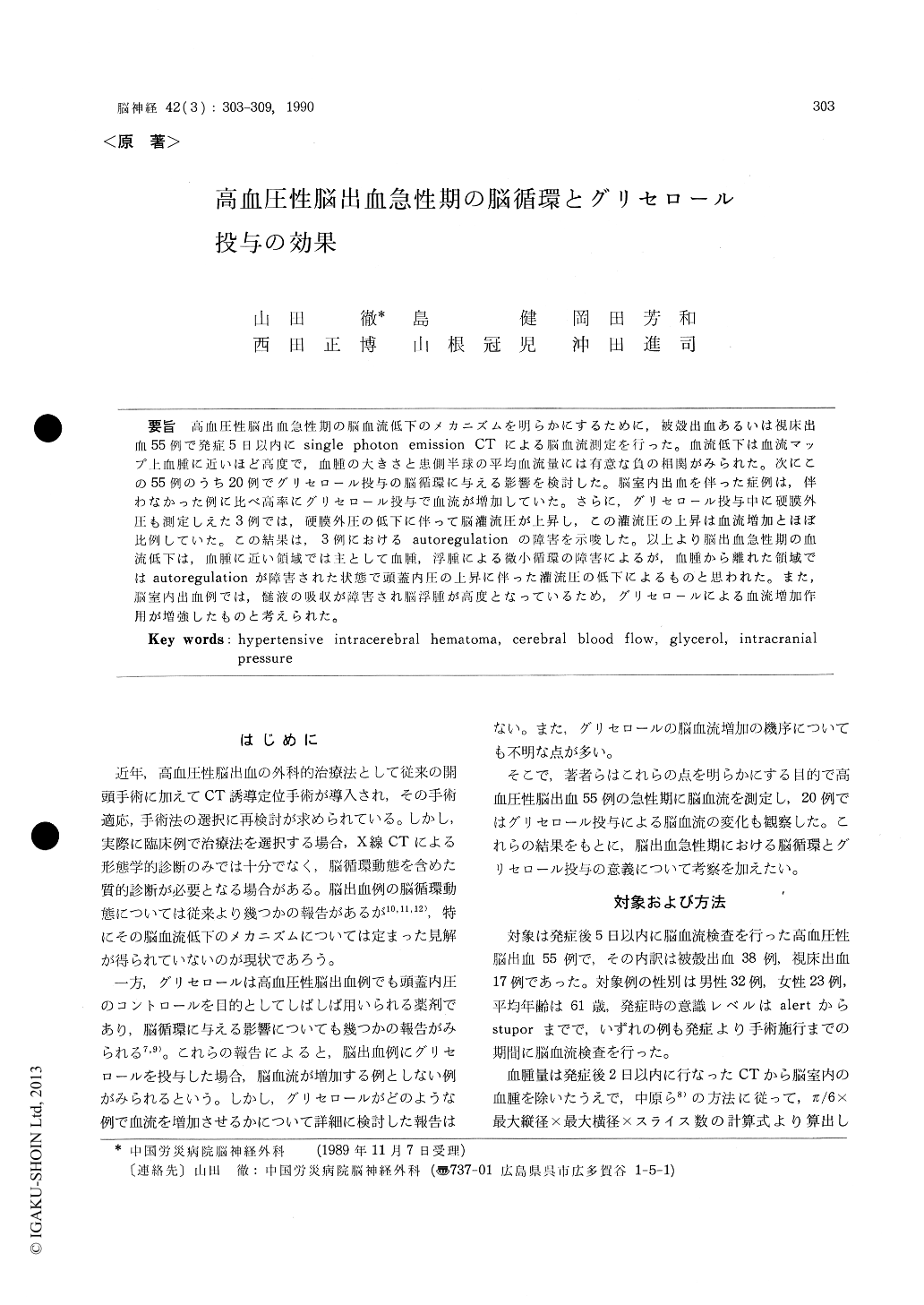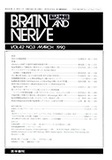Japanese
English
- 有料閲覧
- Abstract 文献概要
- 1ページ目 Look Inside
高血圧性脳出血急性期の脳血流低下のメカニズムを明らかにするために,被殻出血あるいは視床出血55例で発症5日以内にsingle photon emission CTによる脳血流測定を行った。血流低下は血流マップ上血腫に近いほど高度で,血腫の大きさと患側半球の平均血流蟄には有意な負の相関がみられた。次にこの55例のうち20例でグリセロール投与の脳循環に与える影響を検討した。脳室内出血を伴った症例は,伴わなかった例に比べ高率にグリセロール投与で血流が増加していた。さらに,グリセロール投与中に硬膜外圧も測定しえた3例では,硬膜外圧の低下に伴って脳灌流圧が上昇し,この灌流圧の上昇は血流増加とほぼ比例していた。この結果は,3例におけるautoregulationの障害を示唆した。以上より脳出血急性期の血流低下は,血腫に近い領域では主として血腫,浮腫による微小循環の障害によるが,血腫から離れた領域ではautoregulationが障害された状態で頭蓋内圧の上昇に伴った灌流圧の低下によるものと思われた。また,脳室内出血例では,髄液の吸収が障害され脳浮腫が高度となっているたあ,グリセロールによる血流増加作用が増強したものと考えられた。
The purpose of the present study was to clarify the mechanism of reduction in cerebral blood flow(CBF) in the acute stage of hypertensive intra-cerebral hematoma and the effect of glycerol in-fusion on the reduced CBF. We examined 55 cases. Thirty-eight cases showed putaminal hema-toma and 17 presented thalamic hematoma. The range of consciousness was from alert to stupor. CBF was measured by single photon emission CT with Xe-133 inhalation within five days after the onset of the hemorrhage. A CBF map was ob-tained at a slice 5 cm above the OM-line and mean CBF of the affected and non-affected hemispheres was calculated. In 20 of 55 cases, 500 ml of gly-cerol was intravenously infused for 60 minutes and thereafter CBF was measured again. Epidural pressure was also recorded at the affected frontal area during glycerol infusion in three of the 20 cases. CBF reduced more profoundly in the area around the hematoma on the CBF map. Mean CBF of the affected hemisphere was negatively correlated with the volume of hematoma by a quadratic regression. After glycerol infusion, 13 of 20 cases showed a significant increase in mean CBF of the affected hemisphere, while the other seven cases showed no increase. Mean CBF in-creased with a higher percentage in cases with ventricular hemorrhage than without ventricular hemorrhage. In three cases where epidural pres-sure was measured during glycerol infusion, mean CBF increased and epidural pressure decreased. The increase in mean CBF was proportional to a rise in perfusion pressure calculated as pressure difference between mean systemic arterial pressure and mean epidural pressure, indicating impaired autoregulation in these cases. More prominent decrease in CBF around the hematoma on the CBF map and the negative correlation between CBF and the volume of hematoma suggest that CBF is reduced mainly by impairment of microcirculation owing to hematoma and surrounding edema in the area around the hematoma. However, it is report-ed by using magnetic resonance imaging that CBF is possibly less influenced by hematoma and edema in the area distant from the hematoma. Thus, in the distant area, CBF appears to be reduced mainly by a decrease in perfusion pressure under impaired autoregulation. On the other hand, glycerol infu-sion was reported to have an effect on cerebrospi-nal fluid (CSF) production and absorption. There-fore, our observation that glycerol infusion was more effective in increasing mean CBF in cases with ventricular hemorrhage suggests that ventri-cular hemorrhage produces serious disturbance in cerebral circulation by reducing CSF clearance and aggravating brain edema, which is effectively improved by glycerol infusion.

Copyright © 1990, Igaku-Shoin Ltd. All rights reserved.


